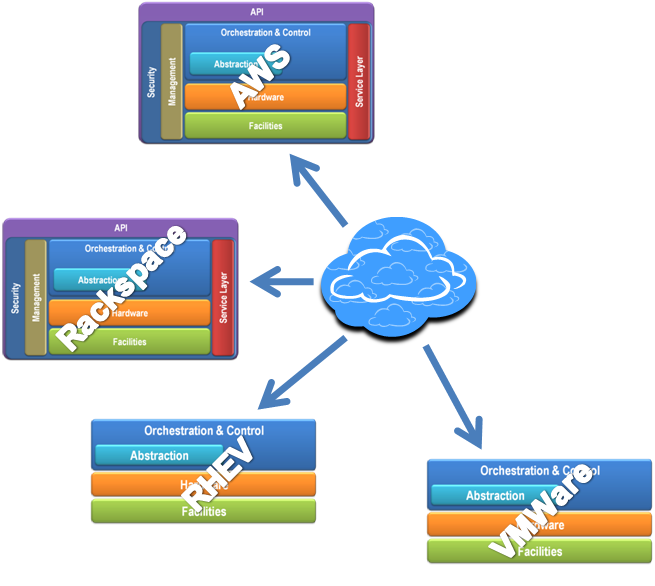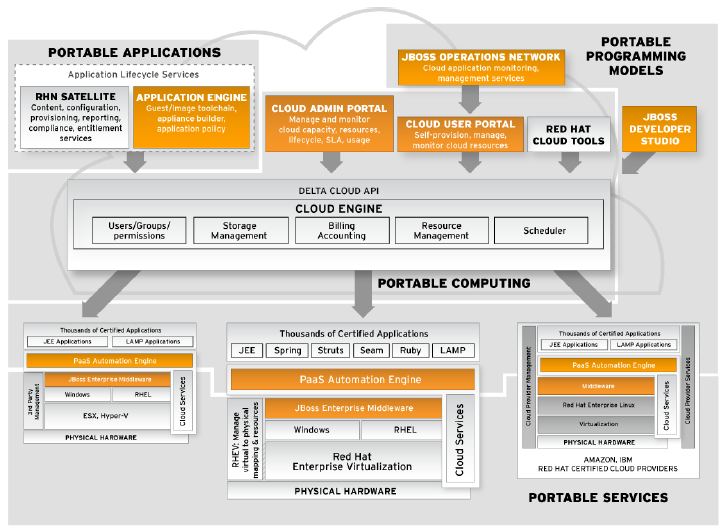RedHat CEO: Don't Get Into the Cloudy Vendor Lock-in
- Transfer
 Wikipedia : “Vendor lock-in” (also “proprietary lock-in”, “customer lock-in”, “vendor lock”, “locking on one supplier”, “barrier to change the supplier”), in the economy - consumer dependence from products and services of one supplier, the inability to change the supplier due to the high cost of the transition.
Wikipedia : “Vendor lock-in” (also “proprietary lock-in”, “customer lock-in”, “vendor lock”, “locking on one supplier”, “barrier to change the supplier”), in the economy - consumer dependence from products and services of one supplier, the inability to change the supplier due to the high cost of the transition. Some time ago I was trying to talk about the Red Hat cloud strategy . Honestly, it didn’t work out very well. :-) Which, in general, is not surprising, it’s difficult to explain everything with a few slides, but the main idea is a single sentence: “ Red Hat will try to occupy the market, providing portability to applications between providers of cloud infrastructure and services."Why is this important, read under the cut (the article is slightly reduced and pictures are added for clarity).
What is the main purpose of cloud computing? The initial and main idea of the clouds was to provide as much computing resources as needed here and now, in this particular In this way, clouds are simply an opportunity to easily or quickly increase or decrease computing power.
The value of cloud computing is that tasks that require huge investments in hardware can now be performed on “rented” equipment, which is much cheaper, because it is not necessary that the computing power be owned by the organization that uses them. However, there is a danger that cloud computing will become an attractive target for unscrupulous providers. Can the “efficiency economy” resist the “vendor lock-in” economy? We must stop and ask ourselves: “Will cloud computing become an example of standardization and freedom of choice, or will they become the next proprietary platform?”
If we do not want to be trapped in vendor lock-in, we must carefully ensure that cloud computing is not a step backward in terms of flexibility and choice of solutions for enterprises.
Jim Whitehurst, president and CEO of Red Hat, argues that CIO has reasonable doubts that with the advent of cloud computing they will get a wide selection of software and competition among cloud service providers. He believes that the next 24 months will be decisive in determining whether the clouds will become an area of “open standards”, allowing customers to save on the cost of resources, or whether they will become a “black box”, beneficial only to suppliers of closed solutions.
Whitehurst is discouraged by the fact that more and more proprietary cloud offers are appearing on the market, whose manufacturers are planting their own, unique, isolated cloud products. “It will lead us into a dead end,” says Whitehurst.
Software manufacturers do not think about whether their product is beneficial for the client. They ask themselves: "How to make the transition to competitors as difficult as possible?" Says Whitehurst. “In fact, customers do not want to get proprietary solutions that trap them in the vendor lock-in trap, but standardized software and the possibility of a wide selection of suppliers. Unless, of course, they see innovation in cloud computing, and not a return to the times of the vertical stacks of the 1980s. ”
Cloud computing is really more flexible than just software and hardware platforms, but if you find yourself locked in proprietary software from one vendor, you may not notice any benefits. “Vendor Lock-in will significantly increase the cost and a significant reduction in funds as a result of improved technical efficiency will not happen,” says Whitehurst.
In order to help standardize cloud computing, Red Hat developed and delivered the Deltacloud open source project to the Apache Software Foundation . The goal of this project is to provide developers with a single, simplified access to various clouds, such as Amazon, IBM, RackSpace, OpenStack, and Eucalyptus, as well as virtualization technologies, for example, to ESX (VMware hypervisor).
The idea behind the creation of Deltacloud is to adopt one standard API for various cloud environments, which will give developers the opportunity to choose at each level of the stack. This will make cloud computing more like Linux, in the sense that they will be based on common standards, and not allow the situation that happened with Microsoft Windows, when it all depends on one company, which receives most of the profit from the ecosystem around this platforms.

The ability to choose which of the “clouds” your applications and data will be in is a necessary feature of cloud computing, according to Red Hat
If the Deltacloud project is successful, it will be possible to create applications that can be run both in a virtual machine, in a data center, in private and public clouds, without the need to make changes. Such flexibility and freedom of choice will be an important tool for modern CIO, whose role has changed dramatically over time.
The skill set of modern CIO is related to understanding the business strategy and management in the company. The understanding that his work consists not only in strengthening all of IT as a whole, but also in that users have the opportunity to bring something innovative, apply their IT knowledge in relation to modern technologies in order to help users realize their ideas into working solutions.
In this case, avoiding vendor lock-in becomes extremely important. User applications and tools must be mobile both within the enterprise and in cloud computing. It is vital that they are designed so that they can be deployed according to user needs and not the conditions dictated by the supplier.

Deltacloud is central to the Red Hat cloud strategy.
With Deltacloud, Red Hat hopes to demonstrate the speed and power of open source technologies for CIO and end users. Deltacloud should open up the possibility of competition and freedom of choice in the cloud market, just as Red Hat Linux opened it in the hardware market, eliminating the "cost of transition" to a new stack of proprietary offers. Cloud computing users should invest in applications that truly bring them benefits.
“The reason we pay so much attention to this issue is not because Linux is better than Unix; and that we all unexpectedly discovered the spirit of competition and the freedom to choose hardware, ”says Whitehurst. “I can record software once, and choose among hardware suppliers. This results in tangible savings. In the case of Deltacloud, the same principle applies: write your application once and use it in your private cloud, in your own data center, or move it to a public cloud. We don’t touch where you want to place your applications, but it’s important for us that you have the opportunity to change your mind and move to another provider of software or services. ”
Vendor lock-in is one of the reasons for large expenses in IT departments, says Whitehurst. With an independent approach to cloud computing, such as Deltacloud, the advantage will be on the side of the company, rather than the supplier of the "cloud" infrastructure.
